Seafloor Subsidence Evaluation Due to Hydrate Depressurization Recovery in the Shenhu Area, South China Sea
Abstract
:1. Introduction
2. Methodology
2.1. Solution Strategy
2.2. Hydrate Model
2.3. Hydrate Constitutive Model
2.4. Analysis of Porous Media
3. Numerical Model Set Up
3.1. Site Location and Description
3.2. Model Domains
3.3. Initial State and Boundary Conditions
3.4. Recovery Scenarios
4. Results and Discussion
4.1. Procedure of Hydrate Dissociation
4.2. Stratum Geomechanics Response
4.2.1. Pore Pressure Distribution
4.2.2. Stress Distribution
4.2.3. Seepage Response
4.3. Seabed Strata Stability
4.4. Influence of Recovering Pressure on Formation Stability
5. Conclusions
- (1)
- The rate of hydrate dissociation is influenced by fluctuations in production pressure; an increase in pressure affects the dissociation rate. Additionally, there is a positive correlation between the distance from the hydrate temperature and pressure to the phase equilibrium curve and the rate of hydrate dissociation.
- (2)
- The reduction of pore pressure and the corresponding increase in effective stress due to hydrate decomposition impact the overall stability of the formation. Stress redistribution leads to compaction of the surrounding strata, decreasing porosity and permeability, and trapping pore pressure, which further influences hydrate dissociation rates and patterns.
- (3)
- Hydrate dissociation in the Shenhu area is unlikely to cause large-scale submarine landslides. However, it may result in several meters of seafloor subsidence across a broad area. Notably, the subsidence observed during the first 50 days of hydrate production accounts for approximately half of the total settlement observed after two years of production. Therefore, monitoring seafloor subsidence dynamics in the early stages of production is essential.
- (4)
- While a higher production pressure drop can accelerate the recovery rate, it also increases the risk of severe seafloor subsidence and slippage. Therefore, it is crucial to strike a balance between the rate of hydrate production and the stability of the formation in project design and planning.
Author Contributions
Funding
Institutional Review Board Statement
Informed Consent Statement
Data Availability Statement
Conflicts of Interest
References
- Song, B.; Cheng, Y.; Yan, C.; Lyu, Y.; Wei, J.; Ding, J.; Li, Y. Seafloor subsidence response and submarine slope stability evaluation in response to hydrate dissociation. J. Nat. Gas Sci. Eng. 2019, 65, 197–211. [Google Scholar] [CrossRef]
- Gajanayake, S.M.; Gamage, R.P.; Li, X.-S.; Huppert, H. Natural gas hydrates—Insights into a paradigm-shifting energy resource. Energy Rev. 2023, 2, 100013. [Google Scholar] [CrossRef]
- Yan, C.; Chen, Y.; Tian, W.; Cheng, Y.; Li, Y. Effects of methane-carbon dioxide replacement on the mechanical properties of natural gas hydrate reservoirs. J. Clean. Prod. 2022, 354, 131703. [Google Scholar] [CrossRef]
- Wei, N.; Pei, J.; Li, H.; Zhou, S.; Zhao, J.; Kvamme, B.; Coffin, R.B.; Zhang, L.; Zhang, Y.; Xue, J. Classification of natural gas hydrate resources: Review, application and prospect. Gas Sci. Eng. 2024, 124, 205269. [Google Scholar] [CrossRef]
- Yan, C.; Dong, L.; Ren, X.; Cheng, Y. Stability of submarine slopes during replacement of methane in natural gas hydrates with carbon dioxide. J. Clean. Prod. 2023, 383, 135440. [Google Scholar] [CrossRef]
- Jin, G.; Lei, H.; Xu, T.; Xin, X.; Yuan, Y.; Xia, Y.; Juo, J. Simulated geomechanical responses to marine methane hydrate recovery using horizontal wells in the Shenhu area, South China Sea. Mar. Pet. Geol. 2018, 92, 424–436. [Google Scholar] [CrossRef]
- Zhou, S.; Zhao, J.; Li, Q.; Chen, W.; Zhou, J.; Wei, N.; Guo, P.; Sun, W. Optimal design of the engineering parameters for the first global trial production of marine natural gas hydrates through solid fluidization. Nat. Gas Ind. B 2018, 5, 118–131. [Google Scholar] [CrossRef]
- Yamamoto, K.; Dallimore, S.R. Aurora-JOGMEC-NRCan Mallik 2006–2008 gas hydrate research project progress. Fire in the Ice. Nat. Gas Oil 2008, 304, 285–4541. [Google Scholar]
- Yamamoto, K.; Terao, Y.; Fujii, T.; Ikawa, T.; Seki, M.; Matsuzawa, M.; Kanno, T. Operational overview of the first offshore production test of methane hydrates in the Eastern Nankai Trough. In Proceedings of the Offshore Technology Conference, Houston, TX, USA, 5–8 May 2014; pp. 1–15. [Google Scholar]
- Chen, L.; Feng, Y.; Okajima, J.; Komiya, A.; Maruyama, S. Production behavior and numerical analysis for 2017 methane hydrate extraction test of Shenhu, South China Sea. J. Nat. Gas Sci. Eng. 2018, 53, 55–66. [Google Scholar] [CrossRef]
- Reagan, M.T.; Moridis, G.J.; Johnson, J.N.; Pan, L.; Freeman, C.M.; Boyle, K.L.; Keen, N.D.; Husebo, J. Field-Scale Simulation of Production from Oceanic Gas Hydrate Deposits. Transp. Porous Media 2015, 108, 151–169. [Google Scholar] [CrossRef]
- Rutqvist, J.; Moridis, G.J. Numerical studies on the geomechanical stability of hydrate-bearing sediments. SPE J. 2009, 14, 267–282. [Google Scholar] [CrossRef]
- Ahmadi, G.; Ji, C.; Smith, D.H. Numerical solution for natural gas production from methane hydrate dissociation. J. Pet. Sci. Eng. 2004, 41, 269–285. [Google Scholar] [CrossRef]
- Liu, X.; Flemings, P.B. Dynamic multiphase flow model of hydrate formation in marine sediments. J. Geophys. Res. 2007, 112. [Google Scholar] [CrossRef]
- Moridis, G.J. Numerical studies of gas production from methane hydrates. SPE J. 2003, 8, 359–370. [Google Scholar] [CrossRef]
- White, M.D.; Wurstner, S.K.; McGrail, B.P. Numerical studies of methane production from Class 1 gas hydrate accumulations enhanced with carbon dioxide injection. Mar. Pet. Geol. 2011, 28, 546–560. [Google Scholar] [CrossRef]
- Hassanpouryouzband, A.; Joonaki, E.; Farahani, M.V.; Takeya, S.; Ruppel, C.; Yang, J.; English, N.J.; Schicks, J.M.; Edlmann, K.; Mehrabian, H.; et al. Gas hydrates in sustainable chemistry. Chem. Soc. Rev. 2020, 49, 5225–5309. [Google Scholar] [CrossRef] [PubMed]
- Ruppel, C. Permafrost-associated gas hydrate: Is it really approximately 1% of the global system? J. Chem. Eng. Data 2015, 60, 429–436. [Google Scholar] [CrossRef]
- Farahani, M.V.; Hassanpouryouzband, A.; Yang, J.; Tohidi, B. Insights into the climate-driven evolution of gas hydrate-bearing permafrost sediments: Implications for prediction of environmental impacts and security of energy in cold regions. RSC Adv. 2021, 11, 14334–14346. [Google Scholar] [CrossRef]
- Yoon, H.C.; Kim, J. The impacts of scaled capillary pressure combined with coupled flow and geomechanics on gas hydrate deposits. Géoméch. Energy Environ. 2024, 37, 100529. [Google Scholar] [CrossRef]
- Zhang, Y.; Zhang, P.; Hui, C.; Tian, S.; Zhang, B. Numerical analysis of the geomechanical responses during natural gas hydrate production by multilateral wells. Energy 2023, 269, 126810. [Google Scholar] [CrossRef]
- Gupta, S.; Helmig, R.; Wohlmuth, B. Non-isothermal, multi-phase, multi-component flows through deformable methane hydrate reservoirs. Comput. Geosci. 2015, 19, 1063–1088. [Google Scholar] [CrossRef]
- Gupta, S.; Deusner, C.; Haeckel, M.; Helmig, R.; Wohlmuth, B. Testing a thermo-chemo-hydro-geomechanical model for gas hydrate-bearing sediments using triaxial compression laboratory experiments. Geochem. Geophys. Geosyst. 2017, 18, 3419–3437. [Google Scholar] [CrossRef]
- Hyodo, M.; Li, Y.; Yoneda, J.; Nakata, Y.; Yoshimoto, N.; Nishimura, A. Effects of dissociation on the shear strength and deformation behavior of methane hydrate-bearing sediments. Mar. Pet. Geol. 2014, 51, 52–62. [Google Scholar] [CrossRef]
- He, Y.; Song, B.; Li, Q. Coupling Submarine Slope Stability and Wellbore Stability Analysis with Natural Gas Hydrate Drilling and Production in Submarine Slope Strata in the South China Sea. J. Mar. Sci. Eng. 2023, 11, 2069. [Google Scholar] [CrossRef]
- Li, Q.; Zhao, D.; Yin, J.; Zhou, X.; Li, Y.; Chi, P.; Han, Y.; Ansari, U.; Cheng, Y. Sediment Instability Caused by Gas Production from Hydrate-bearing Sediment in Northern South China Sea by Horizontal Wellbore: Evolution and Mechanism. Nat. Resour. Res. 2023, 32, 1595–1620. [Google Scholar] [CrossRef]
- Miramontes, E.; Sultan, N.; Garziglia, S.; Jouet, G.; Pelleter, E.; Cattaneo, A. Altered volcanic deposits as basal failure surfaces of submarine landslides. Geology 2018, 46, 663–666. [Google Scholar] [CrossRef]
- Sun, T.; Wen, Z.; Yang, J. Research on Wellbore Stability in Deepwater Hydrate-Bearing Formations during Drilling. Energies 2024, 17, 823. [Google Scholar] [CrossRef]
- Jamil, M.; Rahman, A.H.A.; Siddiqui, N.A.; Ibrahim, N.A.; Ahmed, N. A contemporary review of sedimentological and stratigraphic framework of the late paleogene deep marine sedimentary successions of West Sabah, North-West Borneo. Bull. Geol. Soc. Malays. 2020, 69, 53–65. [Google Scholar] [CrossRef]
- Jamil, M.; Siddiqui, N.A.; Ahmed, N.; Usman, M.; Umar, M.; Rahim, H.U.; Imran, Q.S. Facies analysis and sedimentary architecture of hybrid event beds in submarine lobes: Insights from the crocker fan, nw borneo, malaysia. J. Mar. Sci. Eng. 2021, 9, 1133. [Google Scholar] [CrossRef]
- Jamil, M.; Siddiqui, N.A.; Umar, M.; Usman, M.; Ahmed, N.; Rahman, A.H.A.; Zaidi, F.K. Aseismic and seismic impact on development of soft-sediment deformation structures in deep-marine sand-shaly Crocker fan in Sabah, NW Borneo. J. King Saud Univ. Sci. 2021, 33, 101522. [Google Scholar] [CrossRef]
- Crutchley, G.J.; Mountjoy, J.J.; Pecher, I.A.; Gorman, A.R.; Henrys, S.A. Submarine slope instabilities coincident with shallow gas hydrate systems: Insights from New Zealand examples. In Advances in Natural and Technological Hazards Research; Springer International Publishing: Berlin/Heidelberg, Germany, 2016; Volume 41, pp. 401–409. [Google Scholar] [CrossRef]
- Dhakal, S.; Gupta, I. Slope instability of submarine sediments due to hydrate dissociation: A case study of Northern Cascadia Margin. Geoenergy Sci. Eng. 2023, 223, 211558. [Google Scholar] [CrossRef]
- Tan, L.; Liu, F.; Huang, Y.; Crosta, G.; Frattini, P.; Cen, X. Production-induced instability of a gentle submarine slope: Potential impact of gas hydrate exploitation with the huff-puff method. Eng. Geol. 2021, 289, 106174. [Google Scholar] [CrossRef]
- Dong, B.-C.; Xiao, P.; Sun, Y.-F.; Kan, J.-Y.; Yang, M.-K.; Peng, X.-W.; Sun, C.-Y.; Chen, G.-J. Coupled flow and geomechanical analysis for gas production from marine heterogeneous hydrate-bearing sediments. Energy 2022, 255, 124501. [Google Scholar] [CrossRef]
- Canals, M.; Lastras, G.; Urgeles, R.; Casamor, J.; Mienert, J.; Cattaneo, A.; De Batist, M.; Haflidason, H.; Imbo, Y.; Laberg, J.; et al. Slope failure dynamics and impacts from seafloor and shallow sub-seafloor geophysical data: Case studies from the COSTA project. Mar. Geol. 2004, 213, 9–72. [Google Scholar] [CrossRef]
- Vanneste, M.; Sultan, N.; Garziglia, S.; Forsberg, C.F.; L’Heureux, J.-S. Seafloor instabilities and sediment deformation processes: The need for integrated, multi-disciplinary investigations. Mar. Geol. 2014, 352, 183–214. [Google Scholar] [CrossRef]
- Wan, Z.-F.; Zhang, W.; Ma, C.; Liang, J.-Q.; Li, A.; Meng, D.-J.; Huang, W.; Yang, C.-Z.; Zhang, J.-F.; Sun, Y.-F. Dissociation of gas hydrates by hydrocarbon migration and accumulation-derived slope failures: An example from the South China Sea. Geosci. Front. 2022, 13, 101345. [Google Scholar] [CrossRef]
- Pinkert, S.; Grozic, J.L.H.; Priest, J.A. Strain-Softening Model for Hydrate-Bearing Sands. Int. J. Géoméch. 2015, 15, 04015007. [Google Scholar] [CrossRef]
- Hu, Z.B.; Yang, Y.X. Study on p-y curves of large-diameter steel pipe piles for offshore wind farm in sand based on in-situ tests. J. Appl. Sci. Eng. 2018, 21, 171–178. [Google Scholar] [CrossRef]
- Kamath, V.A. A perspective on gas production from hydrates. In Proceedings of the JNOC’s Methane Hydrate International Symposium, Chiba City, Japan, 20–22 October 1998; pp. 20–22. [Google Scholar]
- Sun, X.; Mohanty, K.K. Kinetic simulation of methane hydrate formation and dissociation in porous media. Chem. Eng. Sci. 2006, 61, 3476–3495. [Google Scholar] [CrossRef]
- Sánchez, M.; Gai, X.; Santamarina, J.C. A constitutive mechanical model for gas hydrate bearing sediments incorporating inelastic mechanisms. Comput. Geotech. 2017, 84, 28–46. [Google Scholar] [CrossRef]
- Lin, J.; Seol, Y.; Choi, J.H. Geomechanical modeling of hydrate-bearing sediments during dissociation under shear. Int. J. Numer. Anal. Methods Géoméch. 2017, 41, 1523–1538. [Google Scholar] [CrossRef]
- Ling, K.; Wu, X.; Zhang, H.; He, J. Improved gas resource calculation using modified material balance for overpressure gas reservoirs. J. Nat. Gas Sci. Eng. 2014, 17, 71–81. [Google Scholar] [CrossRef]
- Miyazaki, K.; Tenma, N.; Aoki, K.; Yamaguchi, T. A nonlinear elastic model for triaxial compressive properties of artificial methane-hydrate-bearing sediment samples. Energies 2012, 5, 4057–4075. [Google Scholar] [CrossRef]
- Uchida, S.; Soga, K.; Yamamoto, K. Critical state soil constitutive model for methane hydrate soil. J. Geophys. Res. 2012, 117. [Google Scholar] [CrossRef]
- Chen, X.; Zhang, X.; Lu, X.; Wei, W.; Shi, Y. Numerical study on the deformation of soil stratum and vertical wells with gas hydrate dissociation. Acta Mech. Sin. 2016, 32, 905–914. [Google Scholar] [CrossRef]

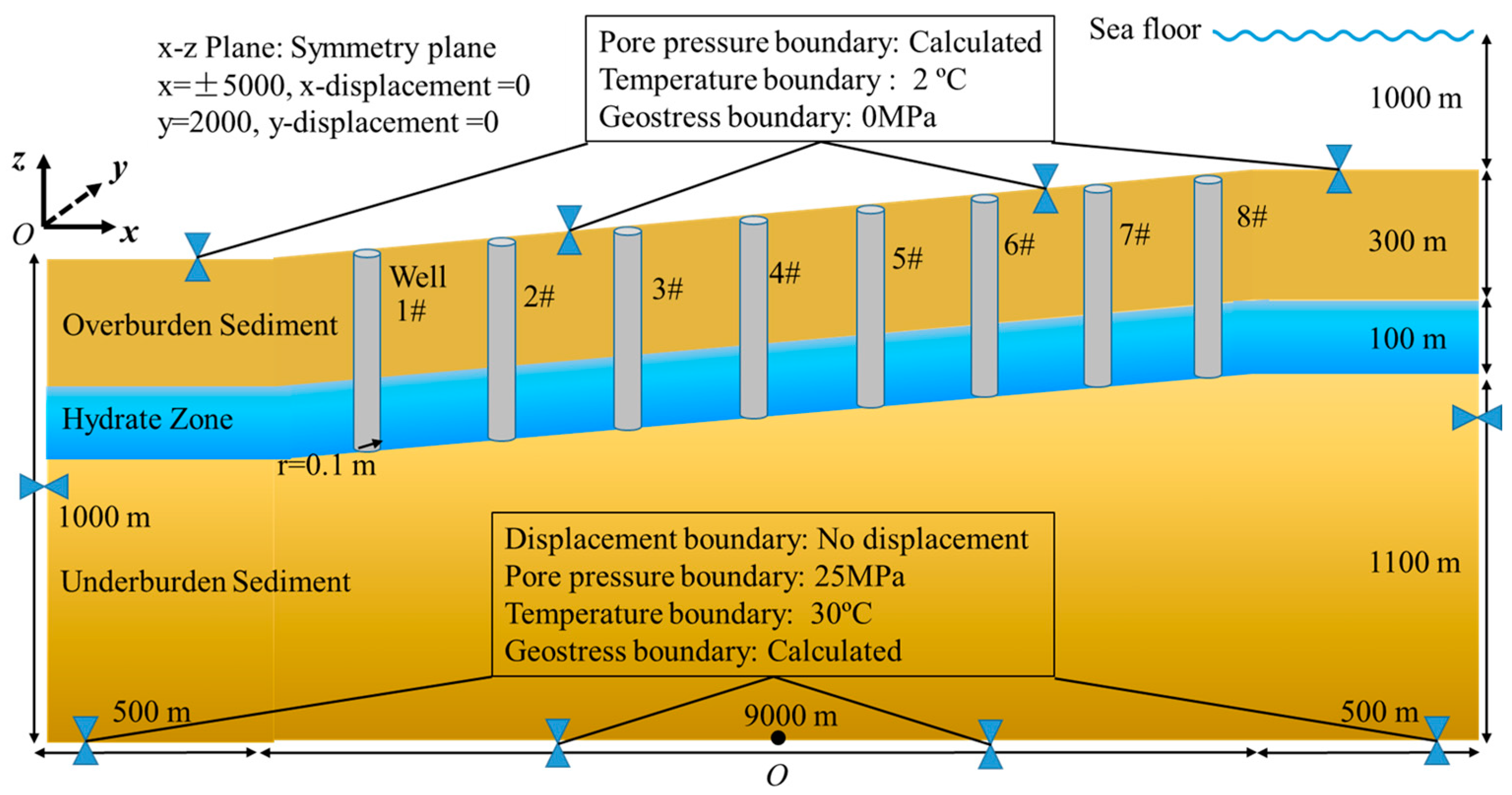
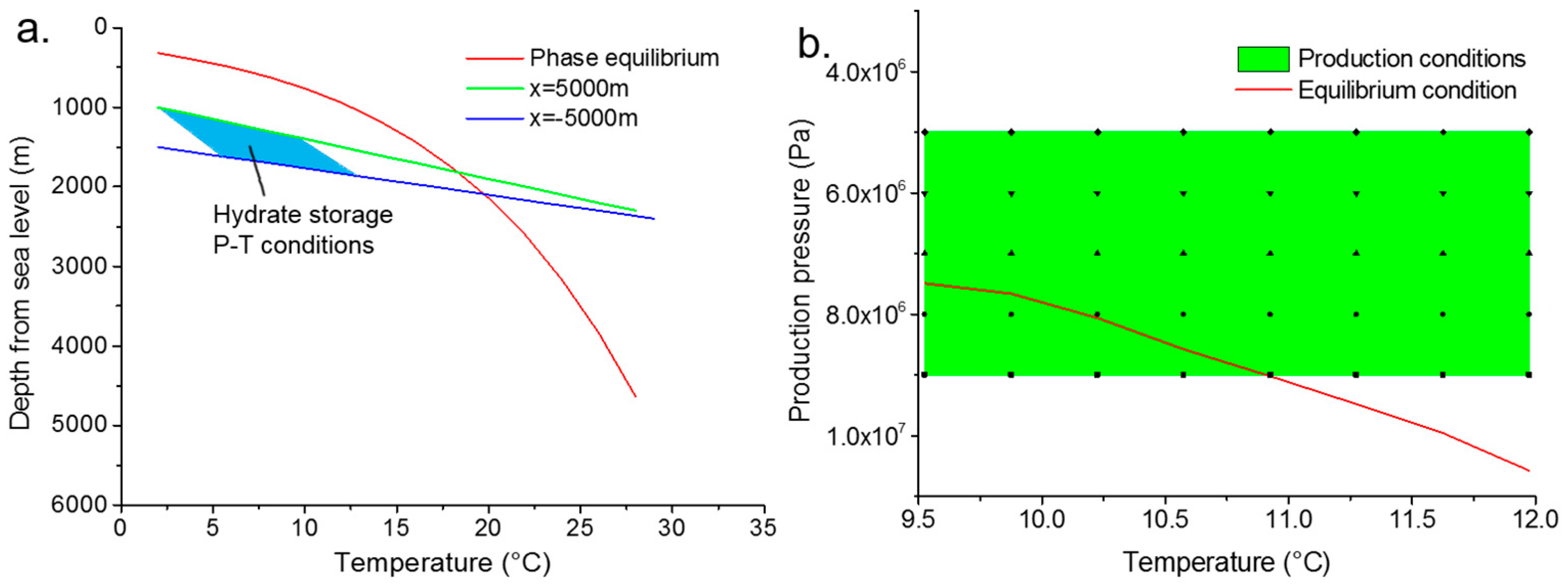
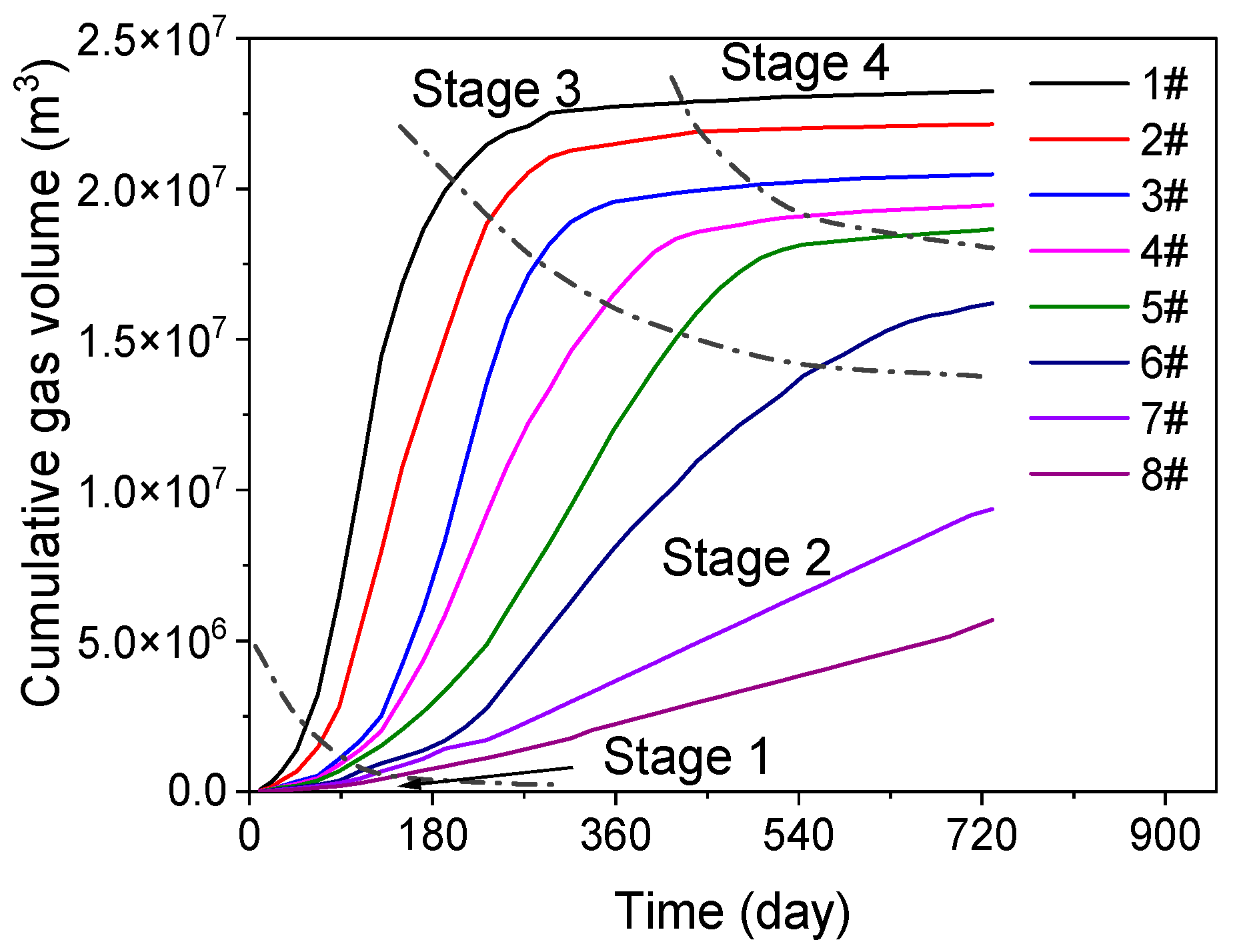
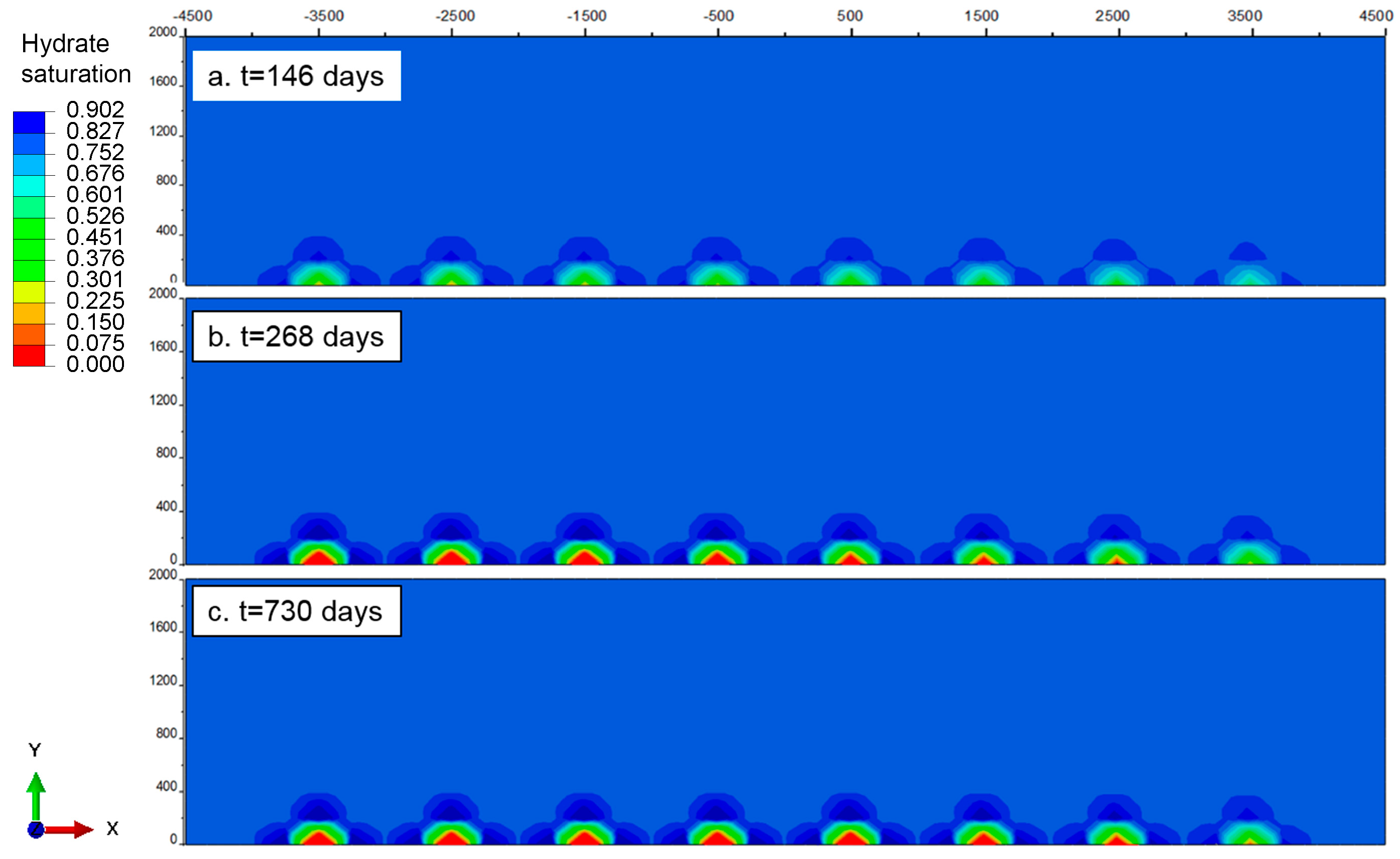
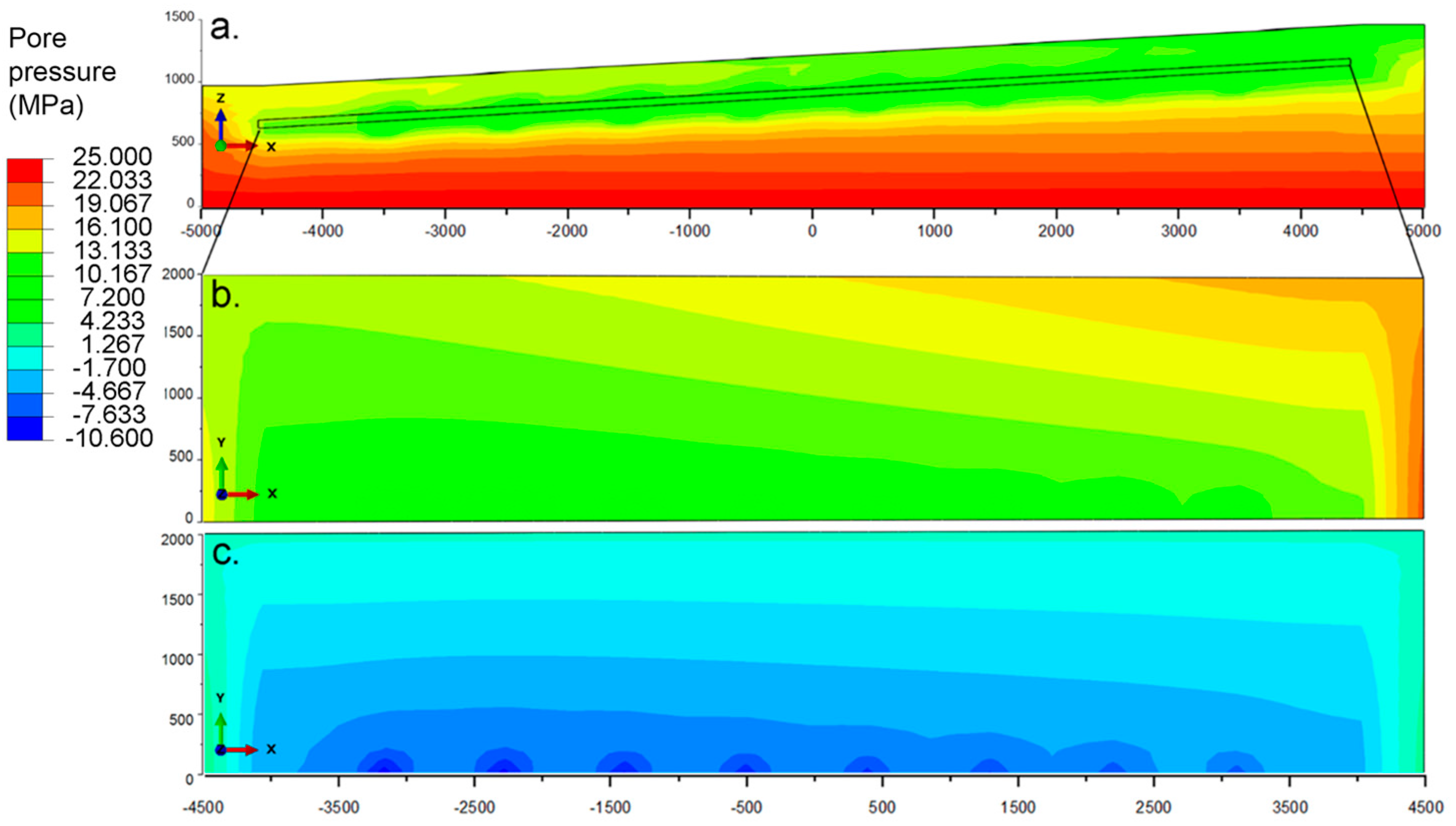
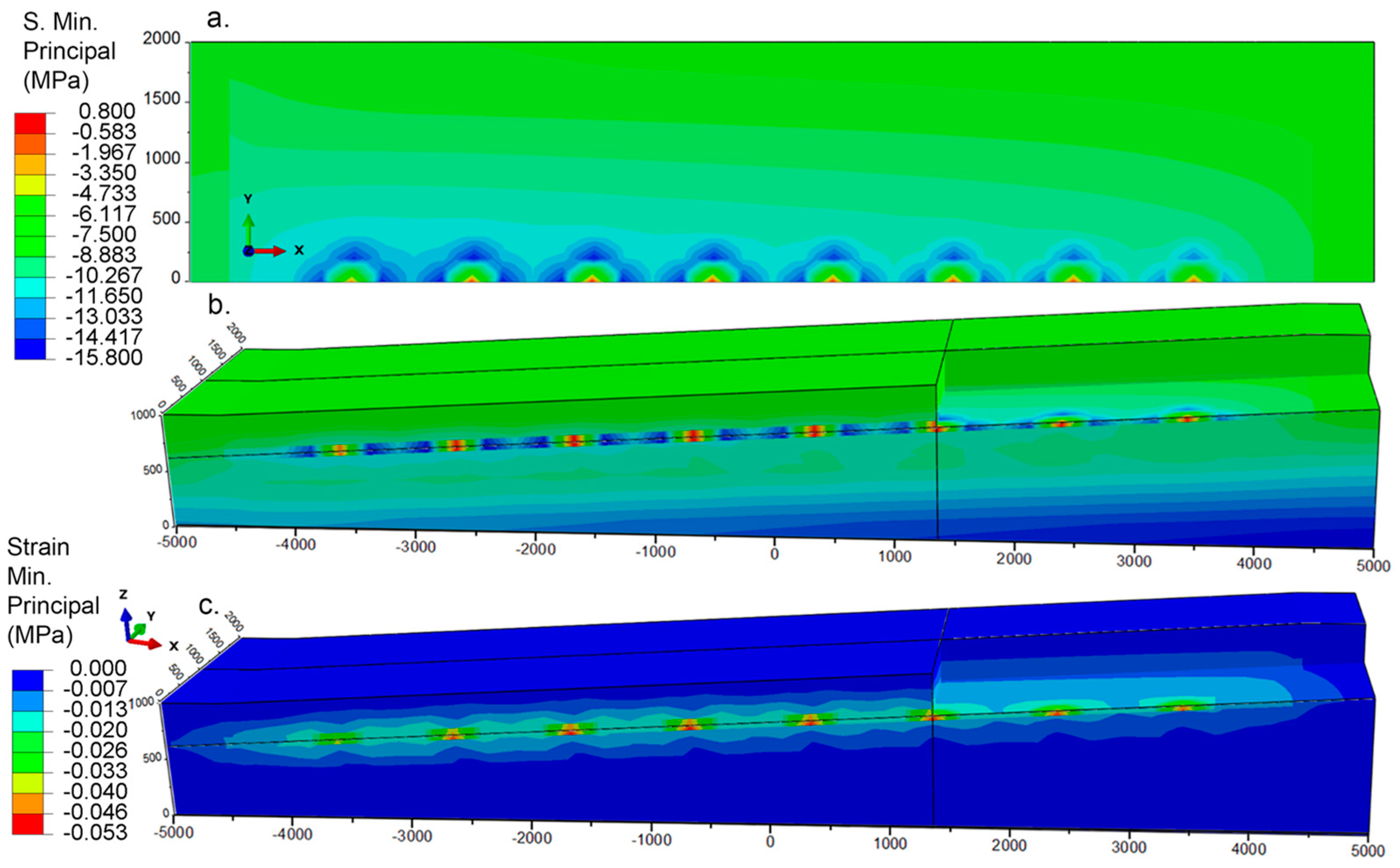
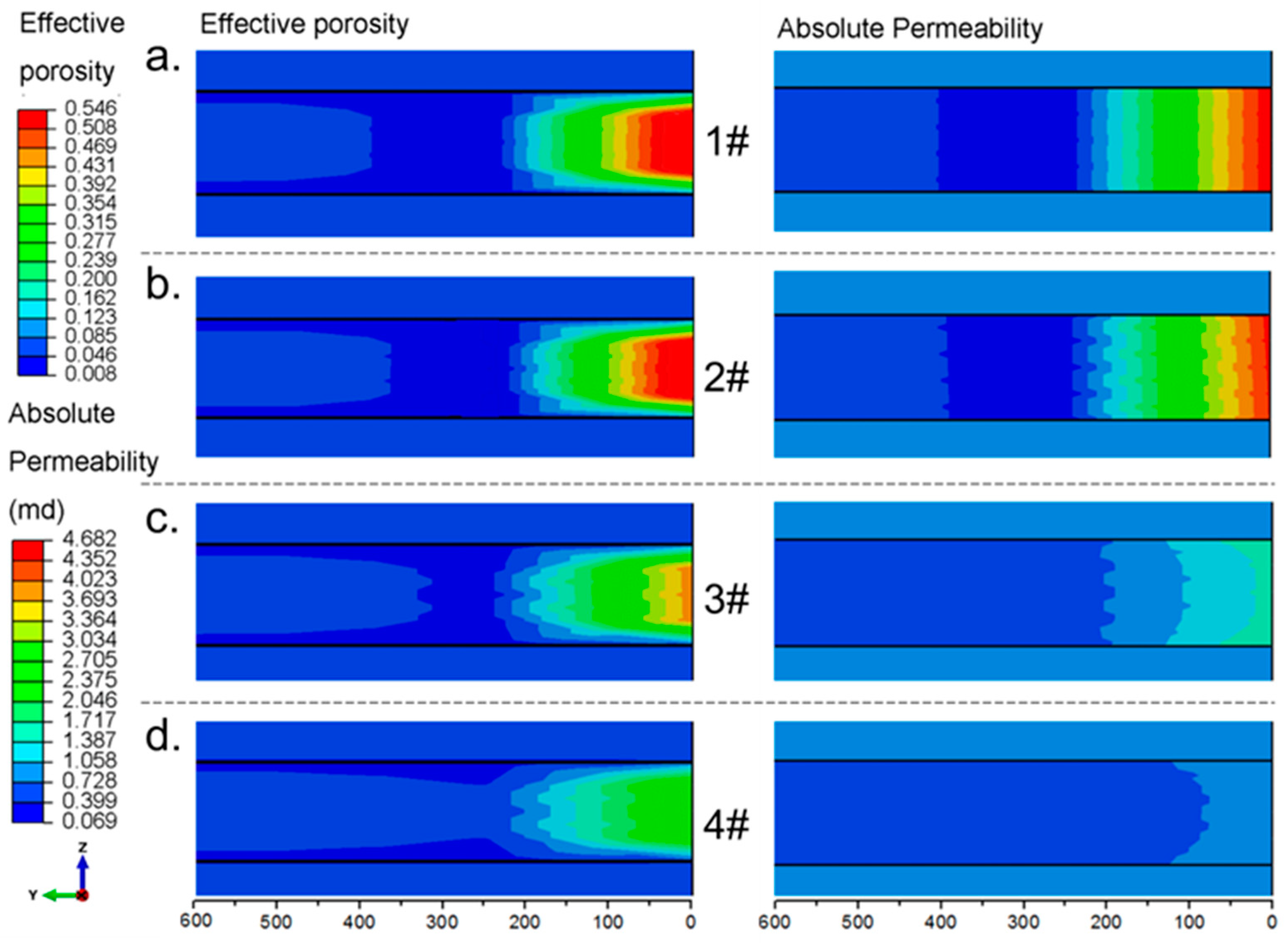
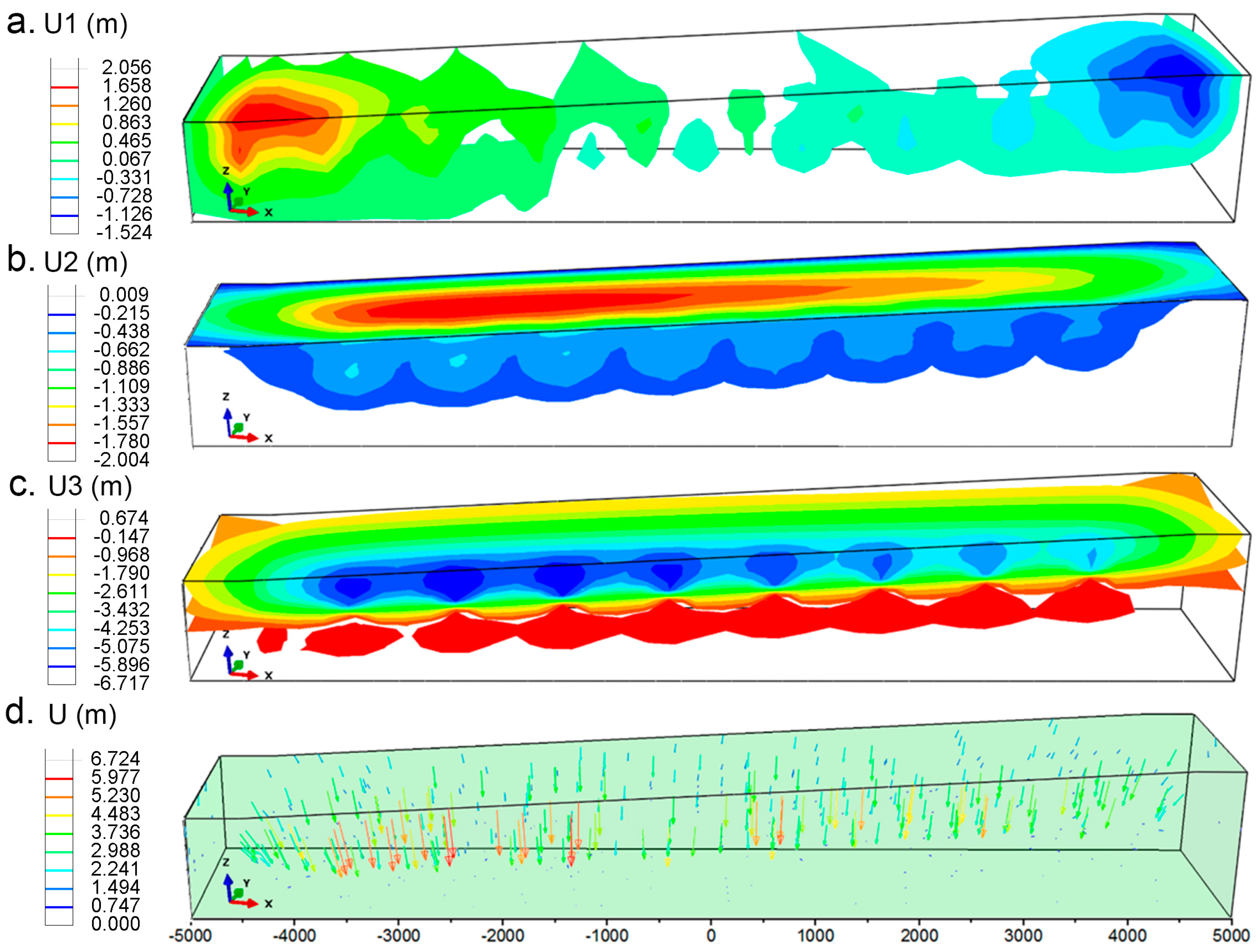
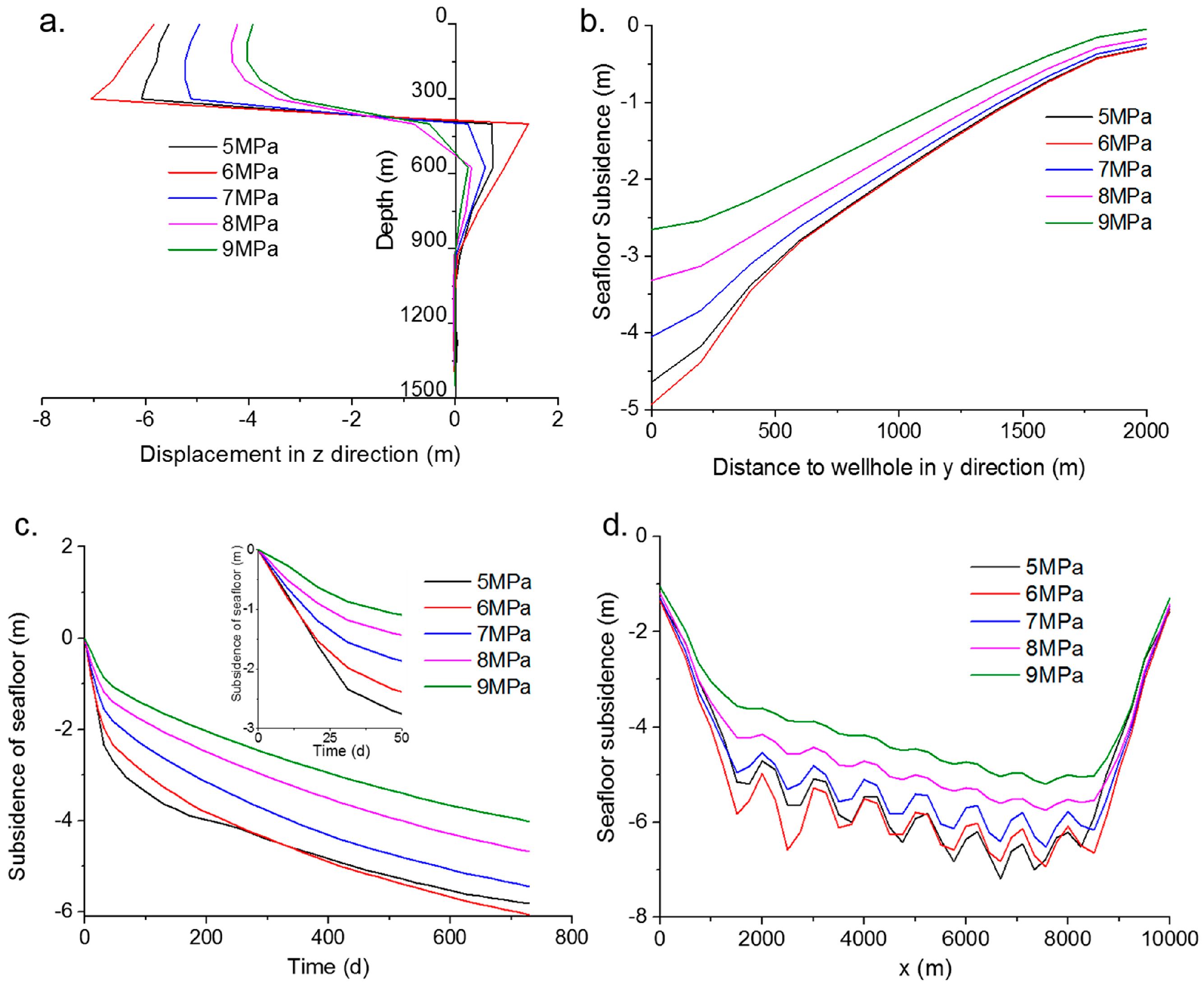
| Parameter | Value | Unit | Parameter | Value | Unit |
|---|---|---|---|---|---|
| 293 | kPa | 0.642 | |||
| 1960 | kPa | 450,000 | kPa | ||
| 1.7 | 1962 | kPa | |||
| 0.4 | 382 | kPa | |||
| 0.1 | 0.22 | ||||
| 2.72 | 0.04 | ||||
| 241,200 | kPa | 9 |
| Parameter | Value | Parameter | Value |
|---|---|---|---|
| Porosity | 0.4 | Sand instinct permeability | 6 mD |
| NGH density | 920 kg/m3 | NGH instinct permeability | 2 mD |
| NGH thermal conductivity | 0.5 W/m K | Liquid density | 1040 kg/m3 |
| NGH specific heat | 2.1 kJ/kg K | Liquid specific heat | 4.2 kJ/kg K |
| Sand density | 2600 kg/m3 | Liquid thermal conductivity | 0.5 W/m K |
| Sand thermal conductivity | 1.0 W/m K | Liquid saturation of Sand | 1 |
| Sand specific heat | 1.0 kJ/kg K | Liquid saturation of sediment | 0.2 |
Disclaimer/Publisher’s Note: The statements, opinions and data contained in all publications are solely those of the individual author(s) and contributor(s) and not of MDPI and/or the editor(s). MDPI and/or the editor(s) disclaim responsibility for any injury to people or property resulting from any ideas, methods, instructions or products referred to in the content. |
© 2024 by the authors. Licensee MDPI, Basel, Switzerland. This article is an open access article distributed under the terms and conditions of the Creative Commons Attribution (CC BY) license (https://creativecommons.org/licenses/by/4.0/).
Share and Cite
Song, B.; Zou, Q. Seafloor Subsidence Evaluation Due to Hydrate Depressurization Recovery in the Shenhu Area, South China Sea. J. Mar. Sci. Eng. 2024, 12, 1410. https://doi.org/10.3390/jmse12081410
Song B, Zou Q. Seafloor Subsidence Evaluation Due to Hydrate Depressurization Recovery in the Shenhu Area, South China Sea. Journal of Marine Science and Engineering. 2024; 12(8):1410. https://doi.org/10.3390/jmse12081410
Chicago/Turabian StyleSong, Benjian, and Qingping Zou. 2024. "Seafloor Subsidence Evaluation Due to Hydrate Depressurization Recovery in the Shenhu Area, South China Sea" Journal of Marine Science and Engineering 12, no. 8: 1410. https://doi.org/10.3390/jmse12081410





